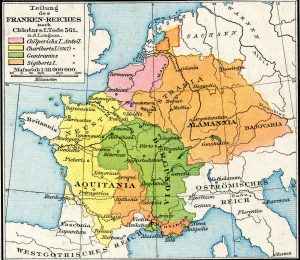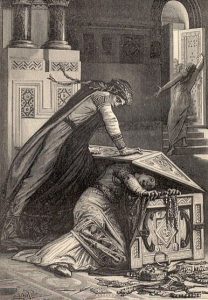
The law, both in its formation and its application, are cornerstones of most developed societies, and certainly the laws and customs of any group can speak volumes towards what exactly is valued by a people in any specific time and place. Our own laws (for the most part) represent not only what we collectively believe to be proper, but also what we believe the state should have powers to regulate. After all, you may believe that it would be impolite for a young person to not give up their seat on the subway for an elderly woman, but you probably don’t think the law needs to get involved on that matter. In the same vein, it is possible to look at Medieval law not only as an articulation of legal principles and morality, but as a testament to both the extents and limits to which the authorities of the era could involve themselves in the private affairs of their communities.
The Salian Law of the Franks is a compilation of the various laws and statutes of the Frankish Kingdom. This code of law, initially meant only for a portion of the population, ended up being revised and edited over multiple generations, and was intended as a personal law rather than a territorial one. That is, instead of the law being applied to a specific territory (such as laws for the state of Ohio, which apply to everyone here) it was applied to any persons who identified ethnically as Franks. We have many writings, both within and beyond the Frankish kingdoms, that confirm that these laws were meant to be applied on a personal basis. For example, a Lombard accused of a crime in the Kingdom of Burgundy might be judged by the Lombard law code, not the Burgundian one. These law codes remained in force for many centuries in Western Europe, and their promulgation marked an important shift in legal history. However, the old Roman law held out, especially through the Catholic church, which operated under Roman law through the Medieval period.
Needless to say, the laws of Europe nearly 1500 years ago were quite different from the laws of our modern age. The most obvious difference is the lack of a division between criminal and civil law. In Frankish law, all crimes, from murder to arson to petty theft, are treated as “damages” that ought to be resolved through some sort of compensation from the offender to the victim and their family. It may seem surprising, but medieval law was far more focused on compensations and reparations than punitive measures in dealing with criminal behavior. The early medieval state did not have the infrastructure for a prison system that would hold convicts as a form of punishment, and they also rarely ever dealt out any form of corporal or capital punishment unless the offending party was a slave, or perhaps if the crime was against the crown (many treasonous individuals were put to death). The primary purpose of the law was not for the state to apprehend and supply suitable punishment to wrongdoers, but for the state to act as a mediator in “disputes” between various feuding individuals and their families. This was the age of the blood feud, when the killing or harming of a family member was grounds for a reciprocal attack upon the aggressor and their family. As such, keeping the peace was less a matter of discouraging crime than discouraging factional violence, which could easily break out of control and leave many dead or injured.

The seminal work of Frankish law is the Pactus Legis Salicae, a code that is believed to have first been compiled under king Clovis I (481-511) and under his sons, and sits as the oldest of the sections of Salian law. Although the work begins with a short section describing fines for failing to answer court summons, the main concern of the text is distinctly rural, as well as agricultural. There are titles concerning theft of pigs, dogs, cows, horses, and even bees (honey, being one of the only sweeteners available, was highly valued). Fields, livestock, houses and gardens were all the basic necessities of life, and so disputes regarding them would be frequent and important, especially in a world where as many as nine-tenths of the population likely would have been involved in agriculture. The same section discusses both the theft of animals and the theft of slaves, suggesting that Frankish people thought of their slaves as less than fully human.
The types of crimes discussed very quickly grow bloodier and more violent. Beyond thefts of an agricultural nature, the text now begins to discuss topics such as breaking into houses, abducting free persons, and perhaps my favorite title to a section, “Concerning Waylaying or Pillaging” (Drew 79). Although the fines in the previous sections could be rather steep, up to 15 solidi in some cases (a solidus was a type of gold coin, though most would have used tremisses, three of which made a solidus), they soon reach the hundreds and more as the intensity of an offense increases, with bodily harm, murder, and even attempted killings by way of hitman. And despite the much greater severity of the crimes committed, the “punishment” if you can call it that, was a required compensation. In addition to paying out to the victim and their kin, the guilty party was also liable to pay part of the fine to the court and presiding judge, as well as to the Rachimburgi, who were the “law speakers” of the court who were expected to remember and repeat the laws of the people by heart, an essential skill in a society where most of the population is illiterate. In fact, a Rachimburg himself could be subject to fine if he failed to repeat the customary law when prompted, up to 15 solidi.
Generally, this first compilation of law was devoted both to things that may be unfamiliar to Roman jurists (who had their own laws) and which the state sought to clarify and enforce its will upon. Later Frankish rulers, calling general assemblies at designated places and times, promulgated Capitularies, which either added new statutes or revised previous ones. Although these edicts were not always successful, they did show an attempt by the Kings and their courts to enforce a uniform interpretation of the law and the establishment of new regulations, regardless of the real success of these efforts. The first capitularies were issued by the sons of Clovis I, and they mark an attempt by the Kings to begin controlling the promulgation of laws and edicts in a manner similar to the Roman Emperors. Initially, they sought to regulate the operation of courts, clarify some vague points in the original compilation, and to discuss laws of inheritance. The next generations, however, were more focused on increasing harshness of punishment for a variety of offenses, especially those offensive to the King and his property, as well as those who served him.

We see some of the first forms of capital punishment, when King Chlothar I (511-561) decrees that, “If anyone finds stolen goods in another man’s house that is under lock and key, the owner of the house shall make composition with his life” (Drew 139). The prevalence of theft seemed to have failed to be handled to such a point that the King thought it necessary to increase the penalties in order to deter this sort of criminal behavior. This trend continued through the years, with various titles concerning crimes now being edited to recommend death for the offending party. Although this can be seen as the state gaining more power over the law and the people, it more likely is indicative of a failure of the state to reduce criminality, and these laws should be seen more from a position of desperation than of strength. Laws that demanded death and loss of all property would certainly have been quite unpopular, and there is no reason to believe that local judges, who already so often operated outside the bounds of written laws, would pay heed to these statutes unless it was politically convenient.
There was also a strong emphasis on family honor, which in some cases was seen as more important than acts of physical violence; the compensation for cutting the hair of someone’s son was greater than cutting their head so as to expose the brain (so long as they lived). Every crime was reckoned in its severity by the measure of how much it would offend the heads of the family, rather than its lethality, or even the real “cost” of the damages. This certainly was a time where honor triumphed over all, and the law was a reflection of that fact. Shearing the hair of a boy (a privilege normally reserved for the father) is truly as insulting as physically attacking them, and had to be treated as such. It was a very different world in the Early Middle Ages, that’s for sure.
Image Citations:
File:Jugement de Childebert III accordant à l’abbaye de Saint-Denis la terre de Hodenc-l’Evêque dans l’Oise.jpg. (2020, May 30). Wikimedia Commons, the free media repository. Retrieved 21:20, October 11, 2020 from https://commons.wikimedia.org/w/index.php?title=File:Jugement_de_Childebert_III_accordant_%C3%A0_l%27abbaye_de_Saint-Denis_la_terre_de_Hodenc-l%27Ev%C3%AAque_dans_l%27Oise.jpg&oldid=422689236.
File:Droysens-20c.jpg. (2020, October 5). Wikimedia Commons, the free media repository. Retrieved 00:40, October 16, 2020 from https://commons.wikimedia.org/w/index.php?title=File:Droysens-20c.jpg&oldid=481712952.
File:Laurens – Récits des temps mérovingiens – Les Magistrats.jpg. (2019, September 4). Wikimedia Commons, the free media repository. Retrieved 01:01, October 16, 2020 from https://commons.wikimedia.org/w/index.php?title=File:Laurens_-_R%C3%A9cits_des_temps_m%C3%A9rovingiens_-_Les_Magistrats.jpg&oldid=364622346.
File:Witt 1887 Fredegund tries to kill her daughter Rigunth.jpg. (2019, August 14). Wikimedia Commons, the free media repository. Retrieved 02:57, October 22, 2020 from https://commons.wikimedia.org/w/index.php?title=File:Witt_1887_Fredegund_tries_to_kill_her_daughter_Rigunth.jpg&oldid=362014078.
Works Cited
Drew, K. F. (1991). The Laws of the Salian Franks. University of Pennsylvania Press.